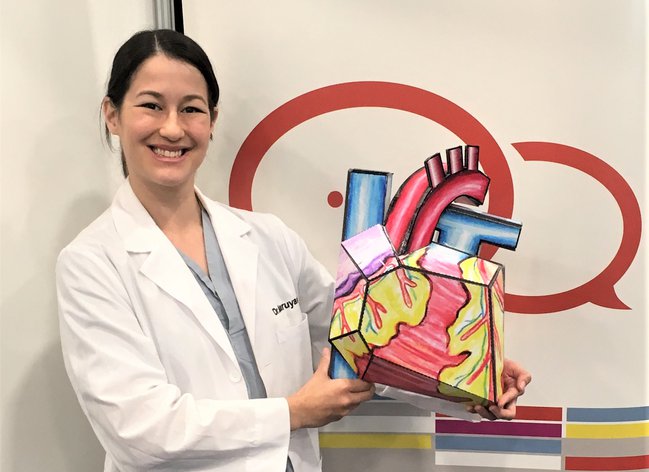With her Play, Learn, Teach! Emerging Leaders in Health Promotion grant project, cardiac surgery resident Dr. Michiko Maruyama, identified a health education gap in the pediatric cardiovascular disease population. She aptly filled that gap with a unique integration of art, design and medicine.
“Cardiovascular disease is on the rise,” says Dr. Maruyama. “And while many health education programs exist to educate the adult population on cardiovascular disease, few programs target the pediatric population.”
As Dr. Maruyama commented in an interview with Metro last summer, “For adults, we often read pamphlets or books with a whole bunch of text in it. But for children, that’s not how they learn … children learn through play.”
And that’s where Dr. Maruyama’s studies in industrial design – she’s currently enrolled in a master’s program at the University of Alberta, focusing on designing health-related toys for children – intersects with her surgical residency at the Mazankowski Alberta Heart Institute.

Dr. Maruyama perceived two needs of young cardiac patients: the need for reassurance in stressful, pre- and post-procedural situations; and the need for education about the heart and related surgical procedures and terminology.
As a medical student, Dr. Maruyama created a “daily doodle” to understand teachings from that day’s classes; she also made anatomical models out of paper – Organami – which form the basis of her educational paper toys. Citing the valuable role that drawing has played in her own medical education, she says, “I greatly support the arts and humanities in medicine, and I think there are many opportunities for collaboration between the two disciplines.”
Dr. Maruyama is tapping into children’s rich imaginations and visual acuity with her creations. For example, her Sternotomy Bear is a paper toy that children cut out, assemble and then open the chest to look at the heart and its parts. It is custom-designed to represent the various heart conditions and procedures. Another, a stuffed teddy bear called the Ostomy Doll, can be disassembled so that children can see internal anatomy and how feeding tubes work.
In 2012, funded jointly by an Emerging Leaders in Health Promotion grant and a grant from the Social Sciences and Humanities Research Council, the series of paper and plush toys representing common heart conditions and procedures has developed and evolved since Dr. Maruyama and a team of fellow second-year medical students at the University of British Columbia Northern Medical Program first created toys for doctors to use as aids in teaching young BC Children’s Hospital patients about their medical conditions.
Although the paper cut-out products are her favorite, because of their economy and accessibility, Dr. Maruyama has many ideas for future educational toys, including more anatomical models, health care action heroes, coloring books and more. She is also using gamification concepts to create surgical simulation kits to teach residents surgical techniques.
However, Dr. Maruyama will never stray far from her printable paper models. “I think education should be available to everyone, and that’s why I choose the materials I do,” she told the Edmonton Journal in an interview last summer. Indeed, her paper cut-out products are available for free on her website: artoflearning.ca.

Supporting health promotion and patient advocacy
With her Play, Learn, Teach! project marrying medicine and industrial/artistic design, Dr. Maruyama was supported and encouraged in her ambitious undertaking by two University of Alberta mentors: Dr. Darren Freed (pediatric cardiac surgery attending) and Professor Robert Lederer (master of industrial design supervisor).
At her project’s primary launch at the U of A’s annual Rockin’ Docs camp last summer, Dr. Maruyama led a team of five medical student volunteers as they helped the children cut out and assemble the toys and engaged the children in conversations about the surgical procedures illustrated by the cut-outs. “As a leader, I encouraged others to consider undertaking creative projects both in medical school and residency.”
“This project has helped me develop creative health promotion advocacy skills,” notes Dr. Maruyama. “It has allowed me to explore art and design and apply both to medical educational resources and health promotion. Additionally, it allowed me to be an advocate for pediatric patients.”
“Some people might view this project simply as toy design,” says Dr. Maruyama. “But I believe that if we can create toys that teach children valuable lessons, then we’re giving them the tools and knowledge to succeed. As an industrial designer in the field of medicine, my goal is to think differently, to develop creative solutions and to advance the medical field one toy at a time.”
About the ELiHP grant program
The Emerging Leaders in Health Promotion (ELiHP) grant program provides funding to help medical students and resident physicians conceive and implement health promotion projects in support of the development of their CanMEDS/FM core competencies, particularly health advocacy.Jointly sponsored by the Alberta Medical Association and the Canadian Medical Association and its subsidiaries – MD Financial Management and Joule – ELiHP projects facilitate the growth of physician leadership and advocacy skills in a mentored environment while enhancing the wellbeing of the general Alberta population through education, advocacy or community service.
Related links
October 5, 2017 | Global News Hour at 6
Alberta woman combines medical expertise with art to help kids
August 22, 2017 | EdmontonJournal.ca
Doctor designs educational toys for children about heart health
August 4, 2017 | ctvnew.ca
Local cardiac surgery resident behind paper toys to help young cardiac patients
Banner photo credit: Dr. Michiko Maruyama

